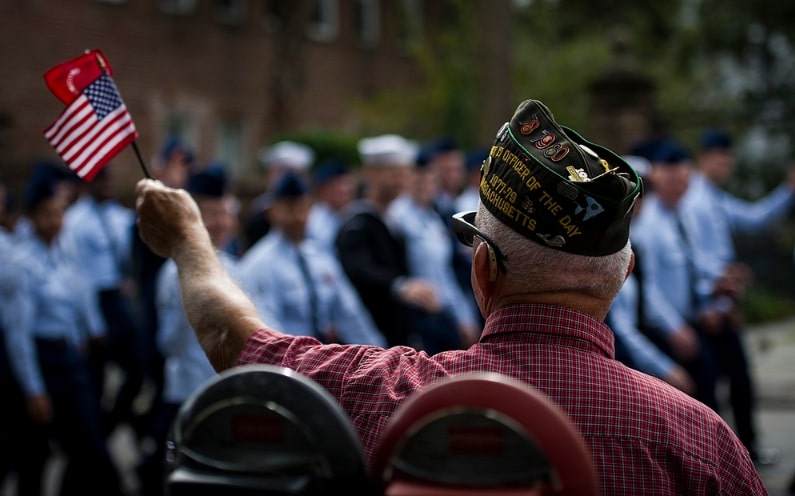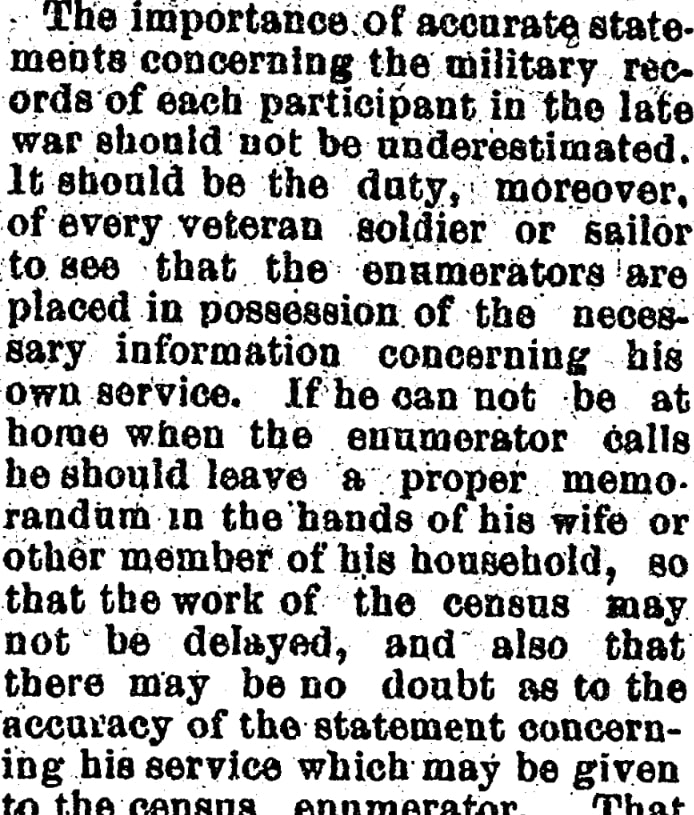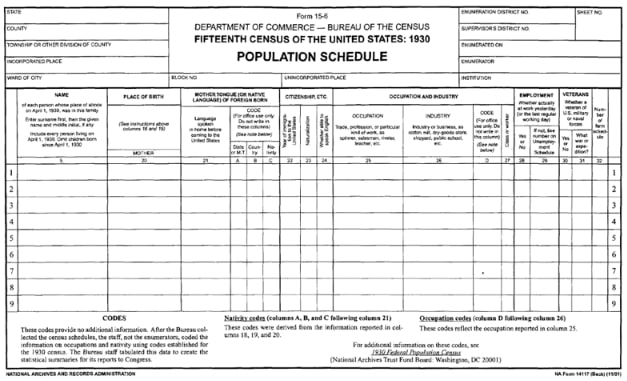Introduction: In this article – to help celebrate Veterans Day – Gena Philibert-Ortega gives tips for finding clues to your ancestor’s military service found in U.S. Federal Census records. Gena is a genealogist and author of the book “From the Family Kitchen.”
Did your ancestors serve in the U.S. military? Depending on how long your family has been in the United States, your answer might include generations going back centuries.
Have you identified all your veteran ancestors? What sources provide clues to military service? One record that can reveal military service is the U.S. federal census. Depending on the census year, clues to military service can be found in 19th and 20th century census returns. While there can be problems with census information, especially since we often don’t know who gave the answers, it’s still a possible clue. (1)

1840 and 1890 U.S. Censuses
We tend to think of a census enumeration as something that is used for “apportionment of representatives, but also to determine the allocation of resources and identify the needs of the people.” (2) The census was occasionally used to specifically count a group of people to determine specific needs. An example is using the census to count veterans and others who were receiving a military pension or who might be eligible for one.
1840 Census
Although the 1840 U.S. Census is not an every-name census and utilized tick marks for everyone other than the head of household, there is an additional schedule for this census that can be helpful for finding those who are not the head of the household.
Titled “A Census of Pensioners for Revolutionary or Military Services with Their Names, Ages, and Places of Residence,” this schedule asked for the name of the pensioner (who may be a widow), age, and the name of the head of household with whom the pensioner lived. This schedule gives you the name of the veteran or their widow (if a widow is named, then you know that the veteran must have died prior to the census), the person’s age, and if they are the head of household or living with someone else. You can then go back to the population schedule and search for that name of the head of household. Finding an ancestor on this schedule means your next step is to order the veteran’s military record and pension file.
To browse this pension schedule for free, see the Census Bureau Library website. You can download the entire schedule, or you can download the states you are interested in. The information is not in alphabetical order, but it is organized by state and then county.
1890 Veteran Census
If you’ve been tracing your family history for any length of time you know that the 1890 U.S. Census population schedule is all but lost due to its almost complete destruction in the 1921 Commerce Building fire. Very few of the enumerations still exist, so for most researchers there simply is no 1890 census.
However, a veteran schedule was added to the U.S. federal census in 1890. As I wrote in my Genealogy 101 blog post about this schedule: According to the United States Census Bureau, the 1890 Veterans Schedule was conducted at the request of the U.S. Pension Office to “help Union veterans locate comrades to testify in pension claims and to determine the number of survivors and widows for pension legislation.” In addition, some congressmen were also interested in this enumeration to learn more about the correlation between military service and longevity. (3)
This schedule was to enumerate Civil War Union soldiers and sailors (Confederate soldiers were not part of this enumeration since they were not eligible for a federal pension – however, there are some that were counted). Over a million veterans and their widows were counted. Information found on this enumeration includes: name, rank, company, name of regiment or vessel, date of enlistment, date of discharge, length of service, post office address, disability incurred, and any additional remarks including details about wounds sustained, where the person was held a prisoner of war, and more. Unfortunately, not all of the schedule still exists. Read my Genealogy 101 article for details.
Genealogy Tip: Consider looking up historical newspaper articles about a particular census. For example, this 31 May 1890 newspaper article informed its readers that questions would be asked about veteran service in the upcoming census. Veterans are counseled to provide their wives or other family member with correct information if they will not be home when the enumerator arrives.

20th Century Censuses: 1900-1950
What schedules include military information from the 20th century? To find military questions look to the 1910 and 1930 censuses as well as the supplementary schedules for the 1940 and 1950 censuses.
1910 Census
In column 30 of the 1910 census, you will find a question that asked whether the person was a survivor of the Union or Confederate Army or Navy. According to the census enumerator instructions: “this question should be asked as to all males over 50 years of age who were born in the United States and all foreign born males who immigrated to this country before 1865.” Abbreviations were:
- Union Army: UA
- Union Navy: UN
- Confederate Army: CA
- Confederate Navy: CN
1930 Census
Columns 30 and 31 of the 1930 census asked about veteran status: “Whether a veteran of the U.S. miliary or naval forces.” Column 30 should have a yes or no answer. Column 31 asked: “What war or expedition?” The problem with this question is that it did not include all veterans. It was a question only for men. Even though women did serve in the military during World War I, they were not to be included.
Enumerator instructions included abbreviations to be used, including:
- World War: WW
- Spanish-American War: Sp
- Civil War: Civ
- Philippine Insurrection: Phil
- Boxer Rebellion: Box
- Mexican Expedition: Mex
The instructions were very specific about who was to be included in this count. For example, in order to be counted as being part of the Mexican Expedition, the veteran had to have gone to Mexico or served in Mexican waters. Similarly, for the Boxer Rebellion, the veteran had to have gone to China or served in Chinese waters. Those who were counted as serving during the World War were counted even if they never left training camp. They had to have served during the years 1917-1921. Keep in mind that the instructions stated: “United States forces.” Although it didn’t say specifically, this would most likely not have included those who served in the Confederacy during the Civil War.
Remember that we don’t know who the informant was for this information. It’s possible it could be wrong. In the case of my great-grandfather, Oscar Philibert, his column 30 states “no” that he was not a veteran. However, he did serve in the Navy during 1917-1921.
Genealogy Tip: Always read the census enumerator instructions to better understand what was asked of your ancestor in a particular census year. Here is a link to the 1930 enumerator instructions. The list of all of the census enumerator instructions can be found on the U.S. Census Bureau website.
1940 Census
If your veteran ancestor was one of the two types of people who answered supplementary questions in the 1940 census, you may learn a little about their military service. Columns 39-41 appeared under the heading “Veterans.” The questions asked: “Is this person a veteran of the United States military forces; or the wife, widow, or under 19-year-old child of a veteran?” Column 39 stated: “If so, enter Yes.” Column 40 asked: “If child, is veteran-father dead (y or n)?” The last column, 41, asked for the War or Military Service.
Unlike the 1930 census enumerator instructions regarding entering information about veterans, the 1940 instructions specified a “man who served in the military forces of the United States (Army, Navy or Marine Corps) in time of war or peace.” This excluded men who were currently serving or who served in other military services such as the National Guard or Reserves.
Column 41 asked for the abbreviation that coincided with the service:
- World War: W
- Spanish-American War, Philippine Insurrection, or Boxer Rebellion: S
- Both Spanish-American War and the World War: SW
- Regular Establishment (Army, Navy, or Marine Corps), peacetime service only: R
- Any other war or expedition: Ot
Keep in mind that the 1940 U.S. Census included a mark to indicate who the informant was (a star inside a circle). Note who in your ancestral family provided the information. Knowing the informant can help you ascertain how accurate the information may have been.
1950 Census
Just like the 1940 U.S. Census, the 1950 U.S. Census included veteran questions for those answering supplementary questions. Six people per enumerator sheet were selected for these additional questions. These questions were intended only for men, and they were asked: Did he ever serve in the U.S. Armed Forces during: World War II (column 33a); World War I (column 33b); Any other time including present service (column 33c).
Once again, reading the questions on the census form isn’t enough. The census enumerator instructions provide more detail as to why your family member may not be counted as a veteran. First, although women were serving in the military prior to 1950, they are not included in this counting of veterans. As with the 1930 census, specific dates were given for service in World War II (September 16, 1940-July 25, 1947) and World War I (April 6, 1917-November 11, 1918, in Europe; to April 1, 1920, in Russia). This differed from the 1930 census which listed World War I from 1917-1921. Other specifics as to whom to include and not include can be found in the 1950 enumerator instructions.
The Census May Have Clues
The census provides more information than just a name, date and place. Make sure that you analyze all of the census information, and then consider what records should be used to follow up on what you have learned. The census can give clues about military service. Aside from the specific veteran questions, a soldier or sailor may have been enumerated on a base or ship. Take a closer look at the census and see what you can discover.
Explore over 330 years of newspapers and historical records in GenealogyBank. Discover your family story! Start a 7-Day Free Trial
GenealogyBank also has the U.S. Federal Census records.
Note on the header image: Oregon State University hosted a Veterans Day Ceremony 10 November 2016 in the Memorial Union Quad. Credit: Theresa Hogue; Oregon State University; Wikimedia Commons.
________________
(1) The informant for information found in the census is unknown except in the 1940 U.S. census, where each household’s informant is noted.
(2) “1840,” U.S. Census Bureau (https://www.census.gov/history/pdf/1840-23objects.pdf ‘;[: accessed 6 November 2023).
(3) “Genealogy 101: The 1890 Veterans Schedule,” GenealogyBank Blog (https://blog.genealogybank.com/genealogy-101-26-the-1890-veterans-schedule.html: accessed 6 November 2023).


